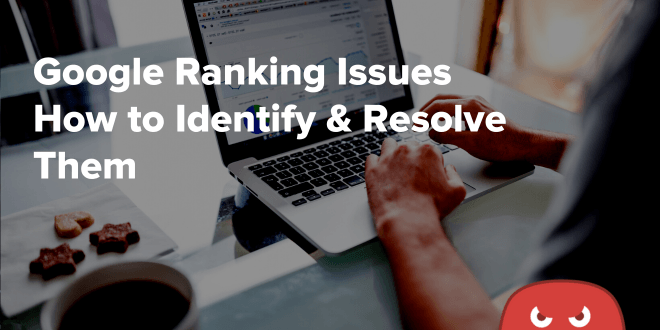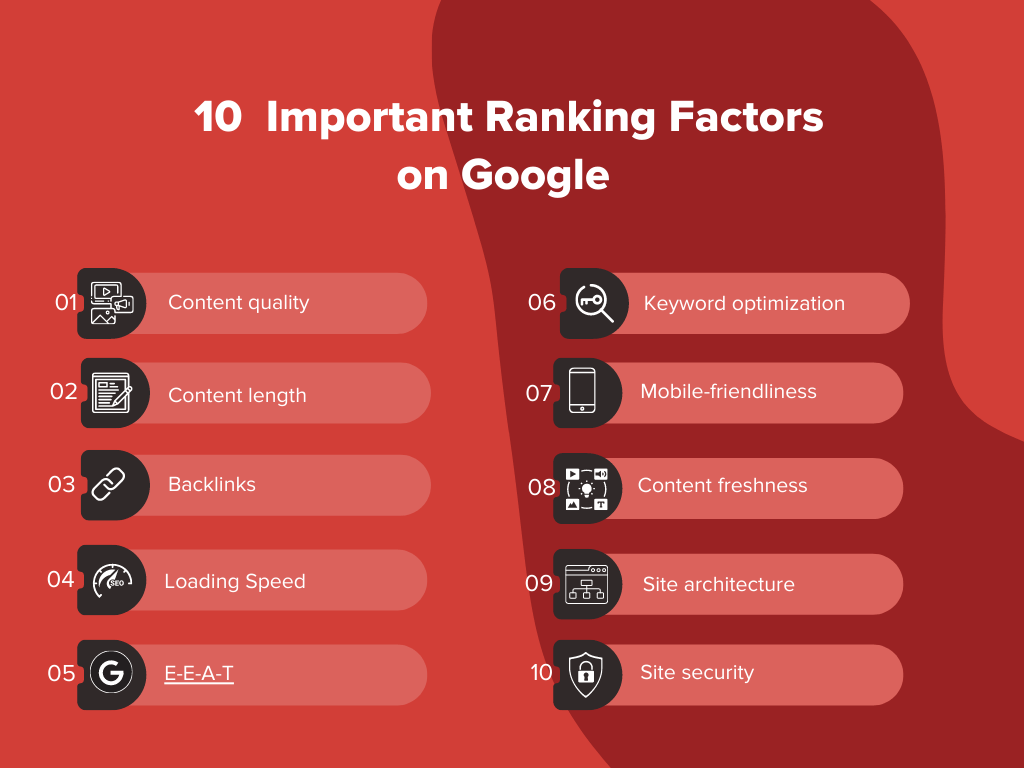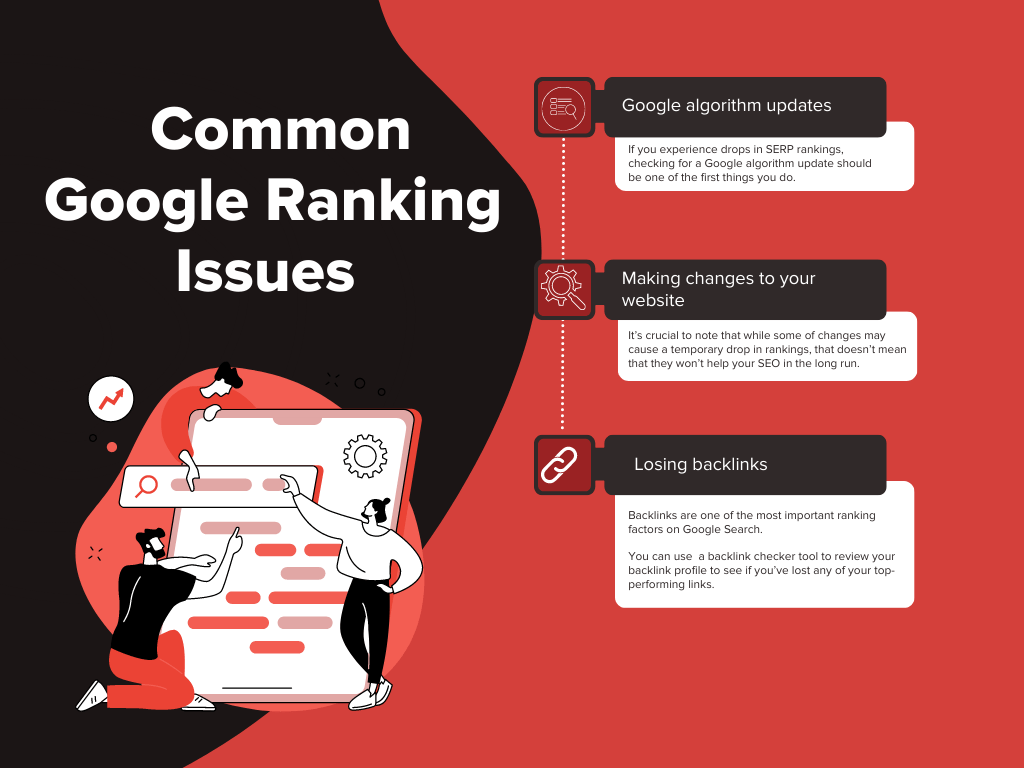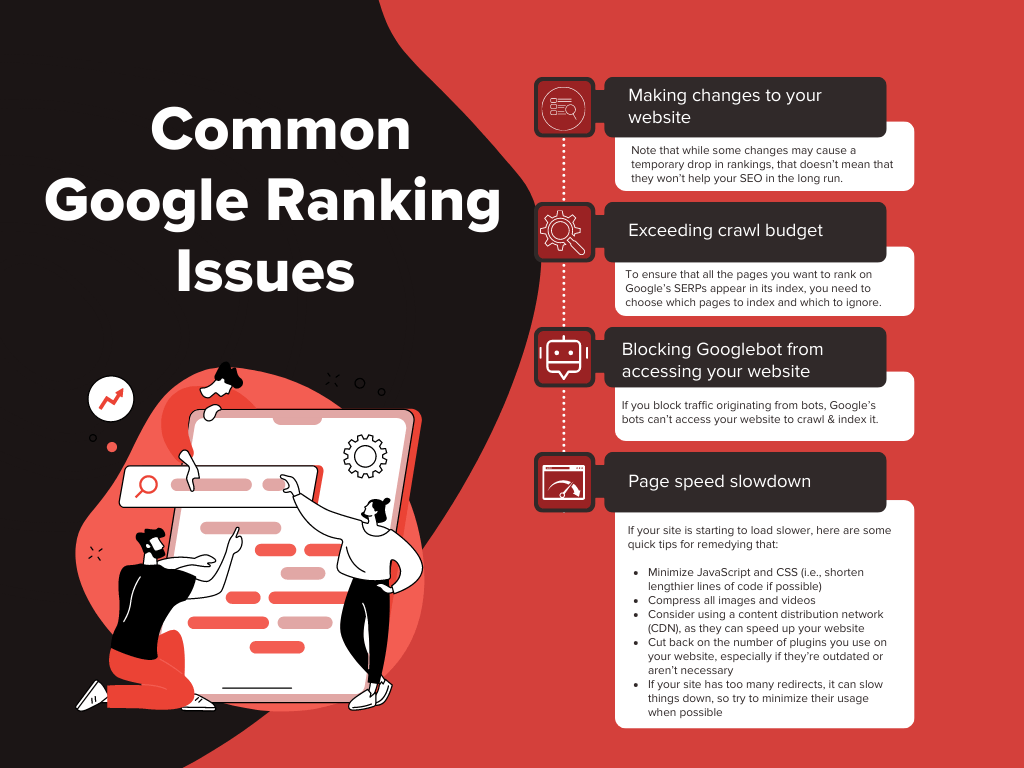
Has one of your web pages disappeared from Google’s SERPs entirely?
Or maybe you’re having trouble getting a page to rank even though it features outstanding content and is well-optimized for SEO.
Either way, you’re experiencing Google ranking issues, which are far more common than you might think.
There are countless on-page and technical SEO factors that can affect your rankings, and some of them can be very sneaky.
For instance, all it takes is one missing asset (such as an image or JavaScript file) to cause a web page to display a 404 error. If that web page happens to be a high-ranking blog or product page, its rankings and traffic will plummet immediately.
Besides issues that occur on your website, external factors can also affect your Google rankings.
Google algorithm updates, lost backlinks, and changes in user behavior can all impact your SERP rankings in a big way.
For instance, Google’s recent Link Spam Update negated the impact paid backlinks had on SEO, causing many websites to see dramatic ranking drops virtually overnight.
Additionally, Google dishes out manual penalties to websites that violate its Webmaster Quality Guidelines.
Black-hat SEO techniques like cloaking, content scraping, keyword spam, and link schemes will land you a penalty if you’re caught, and your rankings will take a serious hit as a result.
The good news is that you can uncover and resolve all these ranking issues, which is what we’re here to help you do today – so read on to learn how.
Understanding Google’s Ranking Factors
To get a better grasp of Google ranking issues, you need to understand how their ranking system works.
Google uses over 200 known ranking factors, and some carry more clout than others.
Not only that, but Google is constantly updating and tweaking its algorithm to resolve issues and provide a better user experience.
As a result, it’s crucial to keep up with the latest Google updates, as well as understand which ranking factors matter most for your content.
10 of the most important ranking factors on Google
While we don’t have enough time to cover all 200 ranking factors, here’s a condensed look at what most SEOs agree are the top 10 factors that affect search rankings on Google.

- Content quality. The relevance and quality of your content are among the most important ranking factors for Google Search.
- Content length. Google’s algorithm values long-form posts that provide a lot of value to users. Research shows that the sweet spot lies around the 2,500-word mark.
- Backlinks. High-authority backlinks are one of the strongest ranking signals on Google, with the #1 spot containing an average of 3.8x more backlinks than positions 2 – 10.
- Loading speed. Google’s Core Web Vitals test will check to see if your website’s loading speed meets its standards. You won’t appear in the top results if you’re too slow.
- E-E-A-T. Google’s quality raters follow an acronym that stands for experience, expertise, authoritativeness, and trustworthiness. These four factors are what Google believes a high-quality result will encompass.
- Keyword optimization. Even if you have outstanding content that’s relevant to your audience, that won’t matter if it’s not optimized with the right keywords.
- Mobile-friendliness. Ever since 2017, Google has practiced mobile-first indexing. That means if your website doesn’t work on mobile devices, you won’t be able to dominate the SERPs.
- Content freshness. Google doesn’t want to provide users with outdated information, which is why they prioritize ranking newer content the highest.
- Site architecture. If your website doesn’t use a logical internal linking structure, some of your most important content may not appear in Google’s index.
- Site security. Google prioritizes safety for its users, which is why they rank sites that use HTTPS higher than HTTP sites.
If any of these 10 factors are missing from your website, that’s likely the cause of your Google ranking issues. If everything checks out, then something else is the culprit.
The Most Common Google Ranking Issues
Whether one of your web pages lost its top ranking spot or you haven’t been able to penetrate the top 10, knowing how to fix Google ranking issues will save the day.
SEOs have been optimizing their websites for Google for decades now, and they’ve run into just about every ranking issue in existence.
That’s actually a good thing, as they’ve likely already figured out a fix for the ranking problem currently giving you headaches.
Here’s a look at the most common Google ranking issues and how to resolve them.
Crawling & indexing errors
If Google’s search bots aren’t able to crawl and index your website, you won’t appear in the SERPs at all.
There are lots of factors that disrupt the crawling process, which is why technical SEO audits are so important.
Redirect errors, soft 404s, noindex tags, and canonical issues will cause crawling errors, bringing the process to a screeching halt.
So if the content you worked so hard on isn’t appearing in Google’s SERPs, it could be that it’s not even in Google’s index.
How can you discover if crawling errors are affecting your website?
You can do this by using Google Search Console (GSC), an extremely useful (and free) tool for site owners to see how Google views their website.
In particular, the Page Indexing Report will let you know how many of your web pages appear in Google’s index.
Moreover, the Index Coverage Report provides a detailed breakdown of any and all crawling/indexing errors Googlebots ran into. The best part is that GSC lets you know details about each error (such as if it’s a problem with a redirect or 404) to make them easier to fix.
Exceeding crawl budget
Also, you need to keep your crawl budget in mind when viewing the Page Indexing Report.
Why is that?
It’s because Google will only have the bandwidth to crawl some of your URLs, namely your most important pages (i.e., blogs, product pages, landing pages, etc.).
So if you’re attempting to index nearly every URL on your website, Google’s search bots will max out your crawl budget – and it may cause some of your most crucial web pages to get left out.
To ensure that all the pages you want to rank on Google’s SERPs appear in its index, you need to choose which pages to index and which to ignore.
Admin pages, login pages, and thank you pages are examples of web pages that you should hit with a noindex tag.
That’s because including these web pages in Google’s SERPs won’t provide any value to your business. There’s no reason why someone would search for one of your admin pages or author archives – nor would generating organic traffic to these pages provide any benefit via sales or leads.
As such, you should only index pages that will help your business and website grow. Everything else should receive a noindex tag to get the most out of your crawl budget.
If you run an eCommerce store, you’ll need to use canonical tags for the ‘vanilla’ version of each product you sell. If you sell multiple colors/sizes of a product, you don’t need to include each one in Google’s index.
Not only does this preserve your crawl budget, but it’ll help you avoid duplicate content.
Blocking Googlebot from accessing your website
If you wake up one morning and realize that your content has disappeared from the SERPs entirely, it could be that Google’s bots can’t access your website to crawl & index it.
Sometimes web administrators grow frustrated with bots browsing their sites and leaving comments on their messaging boards.
As a result, they head into your website’s settings and block all traffic originating from bots.
Now your site will be free of bot spam, and everything will be peachy, right?
It would be, only that now your web pages won’t be able to appear in Google’s search results. Since Google’s search bots are still bots, blocking all traffic from bots will also block them, and they won’t be able to crawl your site.
To ensure this doesn’t happen, make sure that your website allows traffic from bots.
If you aren’t sure if Google is blocked or not, you can use their Rich Results Test to find out. Request a URL from your site and see if it’s able to work. If it doesn’t, it could be that you’ve inadvertently blocked Google from accessing your website.
Page speed slowdown
If a high-ranking web page falls more than a few positions at once, it could be that something is increasing the page load time.
As stated before, Google’s Core Web Vitals test checks every website for loading speed and response times.
Fail the test, and you can kiss your excellent rankings goodbye.
Lots of factors affect page loading times, including JavaScript and CSS, images, videos, plugins, hosting companies, and more.
To discover if your website is having trouble with loading times, you can use Google’s PageSpeed Insights. It’ll let you know if your website is running slow, and it’ll provide suggestions for speeding things up.
If your site is starting to load slower, here are some quick tips for remedying that:
- Minimize JavaScript and CSS (i.e., shorten lengthier lines of code if possible)
- Compress all images and videos
- Consider using a content distribution network (CDN), as they can speed up your website
- Cut back on the number of plugins you use on your website, especially if they’re outdated or aren’t necessary
- If your site has too many redirects, it can slow things down, so try to minimize their usage when possible

Google algorithm updates
If you experience drops in SERP rankings, checking for a Google algorithm update should be one of the first things you do.
Google is constantly making modifications to its algorithm in order to provide a better user experience, resolve issues, and keep up with modern trends.
Most recently, Google released two updates very close to one another in late 2022.
First, they came out with a Link Spam Update on December 12th, 2022.
Just three days later, they announced the update to their Quality Rater Guidelines (E-E-A-T).
Algorithm updates can cause changes in SERP rankings, so it’s essential to do your best to roll with the punches.
Besides major algorithm updates, Google is always making smaller tweaks and changes that draw less attention. For instance, it was uncovered that Google made over 3,000 changes to its search algorithm in the year 2018, and that number has likely increased as time has gone on.
Also, ranking drops don’t always happen overnight, as sometimes the impact of an algorithm update takes some time to appear.
So if you start to notice your rankings are slowly slipping away, an algorithm update could be the reason.
Making changes to your website
Did you recently switch CMS providers and totally redesign your website?
If so, that’s certainly going to affect your search rankings.
The same is true for virtually any change you make to your website, whether you’re switching to HTTPS or tweaking your site architecture.
It’s crucial to note that while some of these changes may cause a temporary drop in rankings, that doesn’t mean that they won’t help your SEO in the long run.
For instance, if you tighten up your site architecture (i.e., using a flat-style design), you may see a brief rankings drop-off, but your SEO profile will be better off – and you’ll likely recover (and maybe even rank higher than before).
Losing backlinks
Lastly, it’s common to experience Google ranking issues whenever you lose a backlink.
As mentioned previously, backlinks are one of the most important ranking factors on Google Search.
Yet, backlinks aren’t set in stone, and website owners may choose to remove your backlink in favor of another one.
After all, that’s the entire methodology behind the skyscraper technique, where you target desirable competitor backlinks to poach by outdoing their content.
That means that the same thing can happen to you in reverse, where one of your competitors snags one of your most effective backlinks.
You can use our free backlink checker tool to review your backlink profile to see if you’ve lost any of your top-performing links.
Concluding Thoughts: Google Ranking Issues
There are lots of factors that can affect your existing Google rankings, some of which are completely out of your control.
The most important thing is to stay calm and perform an SEO analysis whenever you see changes in your rankings. That way, you’ll be able to identify & resolve the issue as soon as possible.
Do you need help ranking higher on Google’s SERPs?
Then you need to check out HOTH X, our five-star managed SEO services. We’ve helped countless clients climb to the top of Google’s search results, and we’d **** for you to be next – so don’t wait to get in touch now.




